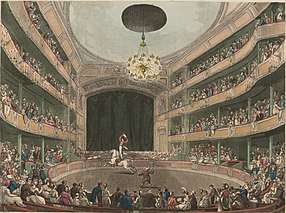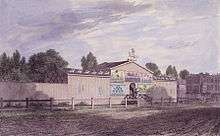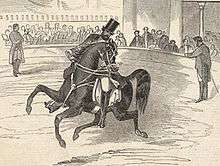Astley's Amphitheatre
Astley's Amphitheatre was a performance venue in London opened by Philip Astley in 1773, considered the first modern circus ring.[1] It was burned and rebuilt several times, and went through many owners and managers. Despite no trace of the theatre remaining today, a memorial plaque was unveiled in 1951 at its site at 225 Westminster Bridge Road.[2]

History


The Amphitheatre opened in 1773 with The Wallet of Time. The structure was burned down in 1794, then rebuilt in less than seven months before being destroyed by fire again in 1803. The Amphitheatre was again rebuilt, this time in the style of rival Charles Hughes’s Royal Circus with lavish decorations and reputedly the largest stage in London.[3] With increasing prosperity and rebuilding after successive fires, it grew to become Astley's Royal Amphitheatre and this was the home of the circus. The location of the theatre was Westminster Bridge Road in Lambeth.[4]
The theatre continued to be popular long after Astley's death in 1814. His brother John succeeded him until he retired three years later, handing over to his partner Davis. This led to a renaming from 'Astley's' to 'Davis's' Amphitheatre.[5] William Batty (1801–1868), perhaps best known as the owner of Batty's Hippodrome, acquired Astley's from Andrew Ducrow (1793–1842) in 1841, after the building sustained its third fire, causing Ducrow to suffer a mental breakdown and die in early 1842. Batty rebuilt the Amphitheatre entirely on his own resources and ran Astley's until 1853. During his tenure, Pablo Fanque, the black circus equestrian and circus owner made his London debut at Astley's in 1847.[6] William Cooke leased the building in 1853 and ran Astley's until 1860.[7][8]
In 1863 the Amphitheatre was turned into the Theatre Royal by Dion Boucicault, however it resulted in failure and left Boucicault heavily in debt.[5] E.T. Smith succeeded Boucicault and provided Adah Isaacs Menken with her first London appearance in Mazeppa to "overflowing houses".[9] Its final owner was "Lord" George Sanger, who bought it for £11,000 in 1871 and ran it as "Sanger's Amphitheatre" for over 20 years. It finally closed and was demolished in 1893.[10][11]
Building structure and design
After the Amphitheatre was rebuilt again after the third fire, it was said to be very grand. The external walls were 148 feet long which was larger than anything else at the time in London. The interior of the Amphitheatre was designed with a proscenium stage surrounded by boxes and galleries for spectators. The general structure of the interior was octagonal. The pit used for the entertainers and riders became a standardised 43 feet in diameter, with the circular enclosure surrounded by a painted four foot barrier.[3] Astley's original circus was 62 ft (~19 m) in diameter, and later he settled it at 42 ft (~13 m), which has been an international standard for circuses since.[12]
The prevailing decorations are white, lemon-colour, green and gold, with rich crimson hangings for the private boxes. There are two full tiers of boxes, and two half tiers, ranging evenly from the two galleries. Each of the full tiers contains nineteen open boxes. The circles are supported from the pit by eight Doric pillars and forty-six Corinthian columns, fluted in white and gold. There are six spacious saloons - two for the dress circle, two for the pit, two for the upper boxes, with extensive refreshment places for the galleries. In the centre of the first tier is the royal box, tastefully ornamented.[13]
— The Illustrated London News, 1843
In popular culture
Jane Austen's 1815 novel Emma credits a visit to Astley's for bringing about the reconciliation and engagement of Robert Martin and Harriet Smith.
Charles Dickens wrote a short story titled Astley's about the theatre, in his 1836 book, Sketches by Boz.[14] He describes an evening at Astley's in chapter 39 of The Old Curiosity Shop, and the circus is also referred to in Hard Times (Book 3 chapter 7) and Bleak House.
Tracy Chevalier's 2007 novel Burning Bright is set at Astley's in 1792-93.
- This article incorporates text from a publication now in the public domain: Gilman, D. C.; Peck, H. T.; Colby, F. M., eds. (1905). New International Encyclopedia (1st ed.). New York: Dodd, Mead. Missing or empty
|title=(help)
See also
- Astley's Amphitheatre (Dublin)
- Amphithéâtre d'Astley (Paris)
- Hippodrama, a theatrical performance involving horses
References
- "Philip Astley | British circus manager". Encyclopedia Britannica. Retrieved 21 October 2019.
- "Theatre Database / Theatre Architecture - database, projects". www.theatre-architecture.eu. Retrieved 21 October 2019.
- "Astley's Amphitheatre". Jane Austen's World. 17 January 2010. Retrieved 21 October 2019.
- Astley's Royal Amphitheatre, Templeman Library, University of Kent
- Hartnoll, Phyllis (1967). Oxford Companion to the Theatre (Third ed.). Oxford University Press. p. 48. Retrieved 21 October 2019.
- "The Illustrated London News," 20 March 1847.
- J. Griffin. "Frost, Thomas (1881), "Circus Life and Circus Celebrities." London: Chatto and Windus". Circushistory.org. Archived from the original on 14 December 2010. Retrieved 9 April 2011.
- Illustrated London News, 20 March 1847.
- Diamond, Michael, Victorian Sensation, Or, the Spectacular, the Shocking, and the Scandalous in Nineteenth-Century Britain, Anthem Press, 2003, p. 270.
- Advert for George Sanger's amphitheatre, British Library Online Gallery, 26 March 2009. Accessed 10 March 2014.
- Rennison, Nick. The Book of Lists, London. Canongate. p. 42.
- "The circus comes to the Circus". BBC News. Retrieved 13 December 2014
- "Victorian London - Entertainment and Recreation - Theatre and Shows - Theatres - Astleys". Retrieved 21 October 2019.
- Sketches by Boz at Internet Archive. Retrieved 2011-4-13.